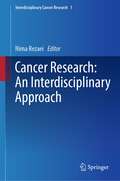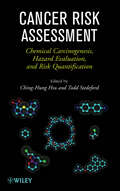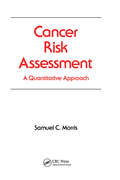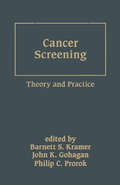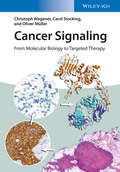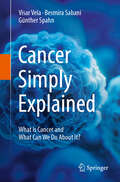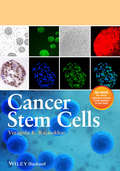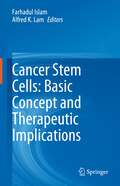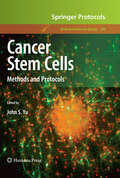- Table View
- List View
Cancer Nanotheranostics: Volume 1 (Nanotechnology in the Life Sciences)
by Muthupandian Saravanan Hamed BarabadiNanotechnology is an interdisciplinary research field that integrates chemistry, engineering, biology, and medicine. Nanomaterials offer tremendous opportunity as well as challenges for researchers. Of course, cancer is one of the world's most common health problems, responsible for many deaths. Exploring efficient anticancer drugs could revolutionize treatment options and help manage cancer mortality. Nanomedicine plays a significant role in developing alternative and more effective treatment strategies for cancer theranostics. This book mainly focuses on the emerging trends using nanomaterials and nanocomposites as alternative anticancer material’s. The book is divided into three main topic areas: how to overcome existing traditional approaches to combat cancer, applying multiple mechanisms to target the cancer cells, and how nanomaterials can be used as effective carriers. The contents highlight recent advances in interdisciplinary research on processing, morphology, structure, and properties of nanostructured materials and their applications to combat cancer.Cancer Nanotheranostics is comprehensive in that it discusses all aspects of cancer nanotechnology. Because of the vast amount of information, it was decided to split this material into two volumes. In the first volume of Cancer Nanotheranostics, we discuss the role of different nanomaterials for cancer therapy, including lipid-based nanomaterials, protein and peptide-based nanomaterials, polymer-based nanomaterials, metal-organic nanomaterials, porphyrin-based nanomaterials, metal-based nanomaterials, silica-based nanomaterials, exosome-based nanomaterials and nano-antibodies. In the second volume, we discuss the nano-based diagnosis of cancer, nano-oncology for clinical applications, nano-immunotherapy, nano-based photothermal cancer therapy, nano-erythrosomes for cancer drug delivery, regulatory perspectives of nanomaterials, limitations of cancer nanotheranostics, the safety of nano-biomaterials for cancer nanotheranostics, multifunctional nanomaterials for targeting cancer nanotheranostics, and the role of artificial intelligence in cancer nanotheranostics.
Cancer Nanotheranostics: Volume 2 (Nanotechnology in the Life Sciences)
by Muthupandian Saravanan Hamed BarabadiCancer Nanotheranostics, Volume 2 continues the discussion of the important work being done in this field of cancer nanotechnology. The contents of these two volumes are explained in detail as follows.In the first volume of Cancer Nanotheranostics, we discuss the role of different nanomaterials for cancer therapy including lipid-based nanomaterials, protein and peptide-based nanomaterials, polymer-based nanomaterials, metal-organic nanomaterials, porphyrin-based nanomaterials, metal-based nanomaterials, silica-based nanomaterials, exosome-based nanomaterials, and nano-antibodies.This important second volume discusses nano-based diagnosis of cancer, nano-oncology for clinical applications, nano-immunotherapy, nano-based photothermal cancer therapy, nanoerythrosomes for cancer drug delivery, regulatory perspectives of nanomaterials, limitations of cancer nanotheranostics, safety of nanobiomaterials for cancer nanotheranostics, multifunctional nanomaterials for targeting cancer nanotheranostics, and the role of artificial intelligence in cancer nanotheranostics.Volume 2 is a vital continuation of this two-volume set. Together, these two volumes create a comprehensive and unique examination of this important area of research.
Cancer RNome: Nature & Evolution
by Mansi Arora Deepak KaulIn the last decade, researchers working in the field of cancer biology have shifted their focus from genetic defects to epigenetic dysregulation, especially that of non-coding RNAs (ncRNAs). This book encompasses a comprehensive review of the transcriptional landscape of the cell and its involvement in the cancer pathophysiology. The first two chapters elucidate the basics of biosynthesis, mechanism of action and modulation of the epigenetic regulation of gene expression by coding as well as non-coding RNAs. The third chapter discusses the aberrant expression of the cellular RNome in the cancer cells and highlights its role in the orchestration of processes involved in evolution as well as the sustenance of cancer cells. The fourth chapter describes the recent advances in the field of translating the transcriptome into diagnostic/prognostic biomarkers and as targets for novel anti-cancer therapies. The final chapter then reviews the emerging experimental approaches to screen, identify and explore the functions of ncRNAs. Providing valuable insights into the field of RNome in the context of cancer, this book is helpful to students, researchers and clinicians..
Cancer Research: An Interdisciplinary Approach (Interdisciplinary Cancer Research #1)
by Nima RezaeiCancer is a major public health concern and one of the leading causes of death. There is no simple solution for this complex disease, therefore interdisciplinary approaches might help to find solutions to many unanswered questions and challenges about cancer. The rapid flow of interdisciplinary research in cancer during recent years has increased our understanding of the nature of cancers. Such interdisciplinary approaches could be helpful for both the diagnosis and the development of more effective therapeutic strategies.The “Interdisciplinary Cancer Research” series publishes comprehensive volumes on different cancers and presents the most updated and peer-reviewed articles on human cancers. Over the past decade, increased cancer research has greatly improved our understanding of the nature of cancerous cells which has led to the development of more effective therapeutic strategies to treat cancers. This interdisciplinary series is of special value to researchers and practitioners working on cell biology, immunology, hematology, biochemistry, genetics, oncology and related fields. This is the main concept of Cancer Immunology Project (CIP), which is a part of Universal Scientific Education and Research Network (USERN).
Cancer Risk Assessment
by Todd Stedeford Ching-Hung HsuWith a weight-of-the-evidence approach, cancer risk assessment indentifies hazards, determines dose-response relationships, and assesses exposure to characterize the true risk. This book focuses on the quantitative methods for conducting chemical cancer risk assessments for solvents, metals, mixtures, and nanoparticles. It links these to the basic toxicology and biology of cancer, along with the impacts on regulatory guidelines and standards. By providing insightful perspective, Cancer Risk Assessment helps researchers develop a discriminate eye when it comes to interpreting data accurately and separating relevant information from erroneous.
Cancer Risk Assessment: A Quantitative Approach (Occupational Safety And Health Ser. #20)
by Samuel C. MorrisBased on the National Academy of Sciences approach to quantitative risk assessment. Emphasizes how an accurate assessment of cancer risk must draw on a wide range of disciplines, such as biology, chemistry, physics, engineering, and the social sciences. Provides tables of Poisson confidence limit fa
Cancer Risk Evaluation: Methods and Trends
by Günter Obe Burkhard Jandrig Gary E. Marchant Holger Schütz Peter M. WiedemannAn overview of the different approaches to cancer risk assessment of environmental factors - including "-omics" technologies, discussing the strengths and weaknesses of the methods in different fields. The main focus is on the carcinogenic effects of ionizing and non-ionizing radiation, demonstrating the difficulties in accurately assessing those factors that may or may not pose a significant cancer risk. The book extends the view to a broader context of risk assessment, highlighting various aspects of risk management. Written by leading experts in the field, this is a resource for policy makers and professionals in health risk assessment, and public health workers, as well as oncologists and researchers in academia. This title is also available as a mobile App from MedHand Mobile Libraries. Buy it now from Google Play or the MedHand Store.
Cancer Screening: Theory and Practice (Basic And Clinical Oncology Ser.)
by Barnett S. Kramer; John K. Gohagan; Philip C. ProrokThis useful reference provides solid knowledge of the risks and benefits associated with the cancer screening process, assesses abnormal results and therapeutic outcomes, and facilitates the communication of these issues to patients. Describes screening tests from individual, health care, ethical, legal, and regulatory perpectives! Gatherin
Cancer Signaling, Enhanced Edition: From Molecular Biology to Targeted Therapy
by Christoph Wagener Carol Stocking Oliver MüllerCancer, which has become the second-most prevalent health issue globally, is essentially a malfunction of cell signaling. Understanding how the intricate signaling networks of cells and tissues allow cancer to thrive - and how they can be turned into potent weapons against it - is the key to managing cancer in the clinic and improving the outcome of cancer therapies. In their ground-breaking textbook, the authors provide a compelling story of how cancer works on the molecular level, and how targeted therapies using kinase inhibitors and other modulators of signaling pathways can contain and eventually cure it. The first part of the book gives an introduction into the cell and molecular biology of cancer, focusing on the key mechanisms of cancer formation. The second part of the book introduces the main signaling transduction mechanisms responsible for carcinogenesis and compares their function in healthy versus cancer cells. In contrast to the complexity of its topic, the text is easy to read. 32 specially prepared teaching videos on key concepts and pathways in cancer signaling are available online.
Cancer Simply Explained: What is Cancer and What Can We Do About It?
by Visar Vela Besmira Sabani Günther SpahnCancer is one of the most feared diseases worldwide, affecting anyone. But what if you were better equipped with sound scientific knowledge to understand, prevent, detect, and treat cancer? This book provides all the essential information on the causes, prevention, and treatment of cancer in an easily understandable manner. It maintains medical precision while explaining in simple terms and uses illustrative comparisons. By employing real-world analogies not found in any other cancer book, complex topics are made accessible. Visually appealing, it combines informative content with visual aids to facilitate understanding Whether you are a patient, survivor, or just interested, this book offers valuable information to better understand and manage cancer.
Cancer Stem Cell Markers and Related Network Pathways (Advances in Experimental Medicine and Biology #1393)
by Shihori TanabeThis book entitled “Cancer Stem Cell Markers and Related Network Path-ways” is about cancer stem cell (CSC) markers and the molecular network pathways. CSCs play an important role in the cancer drug resistance, metastasis and recurrence. Epithelial-mesenchymal transition (EMT) is closely related to CSC phenotype.This book covers various aspects of the molecular networks related to CSCs including the important phenotypic change such as EMT. Readers will discover the importance of the identification of CSC markers and EMT-related molecules in CSC network pathways.The CSC signaling pathways and EMT molecular network pathways attract researchers in the field to define the cancer therapeutic targets. Cancer environment is important in the acquisition of CSC phenotype in cells. The revealing of this CSC mystery is across 7 chapters. The topic of this book is particularly relevant to research in the field of cancer and stem cells, as well as the network pathways. We hope that this book helps the readers to be interested in understanding why the CSC concept is important and attractive.
Cancer Stem Cell Resistance to Targeted Therapy (Resistance to Targeted Anti-Cancer Therapeutics #19)
by Cristina Maccalli Matilde Todaro Soldano FerroneThis book represents an up-dated summary of the state of the art of the characterization of cancer stem cell/ cancer initiating cell (CSC/CIC) properties. An overview of the definition and biological properties of CSCs/CICs as well as the role of these cells in determining the resistance to standard and immune-based therapies is provided. It also discusses limitations in the achievement of a definitive biological characterization of CSCs/CICs due to their high extent of plasticity and heterogeneity that is also mutually driven by the interaction of these cells with the tumor microenvironment. The limitations in targeting CSCs/CICs with immunotherapy are also explained together with explorative combination approaches that could increase the susceptibility of these cells to the recognition by immune cells. This book is conceived for a broad audience, including students, teachers, scientific experts. The critical revision of available results in terms of immunological profile of CSCs/CICs and the efficacy in targeting these cells by immunological approaches, results in a comprehensive and up to date recapitulation of the field and provides interesting suggestions on how to focus future investigations in order to assess the role of CSCs/CICs as prognostic and predictive biomarkers of responsiveness to therapies for cancer patients.
Cancer Stem Cells
by Vinagolu K. RajasekharCancer Stem Cells covers a wide range of topics in cancer stem cell biology, including the functional characteristics of cancer stem cells and how they're generated, where they are localized, the means by which cancer stem cells can be targeted, and how cancer stem cells can be reprogrammed back to normal tissue stem cells. Each chapter begins with a brief historical note and concept summary, followed by a description of the latest basic or clinical advance associated with the topic. Cancer Stem Cells builds systematically from coverage of the basic research stage to an advanced research level, from clinical relevance to therapeutic potential, and will be a valuable resource for professionals in the fields of cancer research and stem cell biology.
Cancer Stem Cells
by William L. FarrarA remarkable paradigm shift has occurred in recent years regarding the biological origins of cancer. The cancer stem cell hypothesis has challenged the foundational notions of cancer, and the therapeutic implications have been profound. Compelling evidence indicates that errors in the development of a small subset of adult stem cells can lead to cancer. Only this small sub-population of cells has the inherent ability to form tumors and metastasize. This book discusses the emerging field of cancer stem cell research, with contributions from leading experts on the basic biology, genetic pathways, and potentials for therapeutic targeting of cancer stem cells. It also covers clinical challenges for these new discoveries, namely, that cancer stem cells might be resistant to conventional chemotherapeutic and radiological treatments and may be at the biological core of relapse and therapeutic resistance. This book is an essential concise guide to the latest discoveries and therapies in cancer research.
Cancer Stem Cells in Solid Tumors (Stem Cell Biology and Regenerative Medicine)
by Alison L. AllanThe "cancer stem cell" hypothesis postulates that cancer arises from a subpopulation of tumor-initiating cells or cancer stem cells (CSCs). While the idea of cancer stem cells has been around for more than a hundred years, evidence from the fields of hematology and cancer biology has now demonstrated the critical role of stem cells in hematological malignancies and suggested that these same mechanisms are also central to the initiation, progression, and treatment of solid cancers. Clinical and experimental studies have shown that CSCs exhibit many classical properties of normal stem cells, including a high self-renewal capacity and the ability to generate heterogeneous lineages; the requirement for a specific "niche"/microenvironment to grow; and an increased capacity for self-protection against harsh environments, toxins, and drugs. Cancer Stem Cells in Solid Tumors represents a detailed overview of cancer stem cells and their role in solid cancers. Comprised of 24 chapters, this volume will provide readers with a comprehensive understanding of this important and evolving field. Topics covered include: Introduction of the CSC hypothesisHistorical perspectives and the contributing lessons from leukemiaCurrent knowledge regarding the identification and role of CSCs in various forms of solid cancer including breast, brain, colorectal, pancreatic, prostate, melanoma, lung, ovarian, hepatocellular, and head and neck cancer Molecular pathways involved in driving CSC function, with a particular focus on the novel convergence of embryonic and tumorigenic signaling pathways In vitro and in vivo assays, model systems, and imaging modalities for studying CSCsThe clinical importance of CSCs for cancer management and treatment, including important implications for prognosis, prediction, and treatment resistanceConsideration of the controversy surrounding the CSC hypothesis and important unanswered questions in this field This collective work was written by a group of prominent international experts in cancer biology, oncology, and/or stem cell biology. It will serve as a valuable resource for established researchers, professors, health care professionals, and students in the medical and scientific community who are investigating stem cells and/or oncology.
Cancer Stem Cells: Basic Concept and Therapeutic Implications
by Alfred K. Lam Farhadul IslamThis book comprehensively reviews the role of cancer stem cells (CSCs) in cancer initiation, progression, and resistance to anticancer therapies. The initial chapters examine the methods and procedure of the detection, isolation, and characterization of CSCs. It also introduces various epigenetic pathways that contribute to cancer initiation and tumorigenesis, particularly regarding the maintenance and survival of CSCs. It also explores the role of CSCs metabolism and the mechanisms of metabolic plasticity of CSCs in cancer biology. Further, it also presents the implications of CSCs on the origin of tumor heterogeneity and on heterogeneity of the therapeutic response. Towards the end, this book highlights the different immunotherapeutic approaches targeting CSCs with the potential of strongly improving cancer outcomes. This book offers a broad framework to scientists and clinicians into the state-of-the-art knowledge on cancer stem cell biology and highlights their therapeutic implications.
Cancer Stem Cells: Methods and Protocols (Methods in Molecular Biology #568)
by John S. YuThrough the revolutionary concept of cancer stem cells, cancer research has been reinvigorated to study the role of these unique cells in cancer propagation and as targets of innovative therapies. In Cancer Stem Cells: Methods and Protocols, preeminent researchers have compiled cancer stem cell research techniques and protocols to promote healthy competition, discourse, and collaboration in this vital field. The volume covers extensive topics such as identification and isolation of cancer stem cells, animal models of cancer stem cells, methylation profiling, the contribution of the niche in the regulation of cancer stem cells, immunologic targeting, and the use of normal stem cells as a treatment, among other subjects. Written in the highly successful Methods in Molecular BiologyTM series format, chapters include brief introductions to their respective topics, lists of the necessary materials and reagents, step-by-step, readily reproducible laboratory protocols, and expert notes on troubleshooting and avoiding known pitfalls. Comprehensive and cutting-edge, Cancer Stem Cells: Methods and Protocols will aid scientists around the world in the furthering of our understanding of cancer initiation and propagation and, most importantly, in the development of novel targets for cancer therapy.
Cancer Stem Cells: New Horizons in Cancer Therapies
by Surajit Pathak Antara BanerjeeThis book discusses the recent developments in the therapeutic implications of cancer stem cells for the effective diagnosis, prognosis, and treatment of cancer. It summarizes the various stem cells of common cancers including colon, pancreas, lungs, prostate, melanoma, and glioblastoma, and reviews the potential role of cancer stem cells in tissue aggressiveness, examining the functional contribution of cancer stem cells in the establishment and recurrence of cancerous tumors. Further, it explores the potential of cancer stem cells as novel therapeutic targets for the treatment and prevention of tumor progression. The book also discusses the various approaches for detecting, isolating, and characterizing different cancer stem cells and signaling pathways that control their replication, survival, and differentiation. Lastly, it explores the key features and mechanisms of drug resistance, chemo-resistance, and radio-resistance in cancer stem cells to improve therapeutic rationale.
Cancer Stem Cells: Philosophy and Therapies
by Lucie LaplaneA new therapeutic strategy could break the stalemate in the war on cancer by targeting not all cancerous cells but the small fraction that lie at the root of cancers. Lucie Laplane offers a comprehensive analysis of cancer stem cell theory, based on an original interdisciplinary approach that combines biology, biomedical history, and philosophy.
Cancer Systems Biology (Chapman & Hall/CRC Computational Biology Series)
by Edwin WangThe unprecedented amount of data produced with high-throughput experimentation forces biologists to employ mathematical representation and computation to glean meaningful information in systems-level biology. Applying this approach to the underlying molecular mechanisms of tumorgenesis, cancer research is enjoying a series of new discoveries and biological insights. Unique in its dualistic approach, this book introduces the concepts and theories of systems biology and their applications in cancer research. It presents basic cancer biology and cutting-edge topics of cancer research for computational biologists alongside systems biology analysis tools for experimental biologists.
Cancer Systems Biology, Bioinformatics and Medicine: Research and Clinical Applications
by Frederick Marcus Alfredo CesarioThis teaching monograph on systems approaches to cancer research and clinical applications provides a unique synthesis, by world-class scientists and doctors, of laboratory, computational, and clinical methods, thereby establishing the foundations for major advances not possible with current methods. Specifically, the book: 1) Sets the stage by describing the basis of systems biology and bioinformatics approaches, and the clinical background of cancer in a systems context; 2) Summarizes the laboratory, clinical, data systems analysis and bioinformatics tools, along with infrastructure and resources required; 3) Demonstrates the application of these tools to cancer research; 4) Extends these tools and methods to clinical diagnosis, drug development and treatment applications; and 5) Finishes by exploring longer term perspectives and providing conclusions. This book reviews the state-of-the-art, and goes beyond into new applications. It is written and highly referenced as a textbook and practical guide aimed at students, academics, doctors, clinicians, industrialists and managers in cancer research and therapeutic applications. Ideally, it will set the stage for integration of available knowledge to optimize communication between basic and clinical researchers involved in the ultimate fight against cancer, whatever the field of specific interest, whatever the area of activity within translational research.
Cancer Systems and Integrative Biology (Methods in Molecular Biology #2660)
by Robert Clarke Usha N. KasidThis thorough volume explores recent advances that have revolutionized the field of precision oncology. The chapters, contributed by experts in the areas of cancer systems and integrative biology, provide hands-on guidance toward developing tools to monitor spatial and temporal changes in tumors, tracking tumor markers in blood, and ultimately developing precision medicine to combat cancer in real time. Written for the highly successful Methods in Molecular Biology series, chapters include the kind of detailed implementation advice that ensures successful results. Authoritative and informative, Cancer Systems and Integrative Biology serves as an invaluable resource for researchers, pharmaceutical scientists, and oncologists interested in expanding their knowledge base in the current developments in cancer research.
Cancer Therapy with Radiolabeled Antibodies
by David M. GoldenbergCancer Therapy with Radiolabeled Antibodies explores the most current experimental and clinical advances in the newly emerging field of cancer radioimmunotherapy (RAIT). Providing a multidisciplinary and international context, some of the world's leading experts examine the problems and prospects of RAIT from radiation, immunological, chemical, physical, physiological, and clinical perspectives with both overviews and original research.Discussions cover the up-to-date clinical results in the RAIT of ovarian, breast, colorectal, and brain cancers, as well as the current status of RAIT in the management of B cell lymphomas. Radiobiology, dosimetry, radiochemistry, targeting biology in experimental models, clinical experiences in hematopoietic and solid tumors, and new approaches to improve cancer radioimmunotherapy are also discussed. In addition, new dosimetry concepts, new labeling methods, new concepts of antibody pharmacokinetics, and new methods to enhance selective cancer radioimmunotherapy are included.
Cancer Virus Hunters: A History of Tumor Virology
by Gregory J. MorganTraces the history of the study of tumor viruses and its role in driving breakthroughs in cancer research.Worldwide, approximately one-fifth of human cancers are caused by tumor viruses, with hepatitis B virus and HPV being the leading culprits. While the explosive growth in molecular biology in the late twentieth century is well known, the role that the study of tumor viruses has played in driving many of the greatest breakthroughs is not. Without the insights gained by studying tumor viruses, many significant theoretical advancements over the last four decades in cellular and molecular biology would not have been made. More practically, the study of tumor viruses has saved thousands, if not millions, of lives.In Cancer Virus Hunters, Gregory J. Morgan traces the high points in the development of tumor virology, from Peyton Rous's pioneering work on chicken tumors in 1909 to the successful development of an HPV vaccine for cervical cancer in 2006. Morgan offers a novel approach to understanding the interconnectedness of a long series of biomedical breakthroughs, including those that led to seven Nobel prizes. Among other advances, Morgan describes and contextualizes the science that prompted the discoveries of reverse transcriptase, RNA splicing, the tumor suppressor p53, the vaccine for hepatitis B, and the HIV test. He also explores how "cancer virus hunters" have demonstrated the virtue of beginning with a simple system, even when investigating a complex disease like cancer.Based on extensive archival research and over fifty interviews with experts, Cancer Virus Hunters is a tour de force summarizing a century of research to show how discoveries made with tumor viruses came to dominate the contemporary understanding of cancer. By showcasing the scientists themselves, the book makes for an unusually accessible journey through the history of science. It will be of interest to biomedical professionals—especially in oncology, hepatology, and infectious disease—in addition to historians of science and anyone interested in cancer research.
Cancer and Inflammation Mechanisms: Chemical, Biological, and Clinical Aspects
by Shosuke Kawanishi Yusuke Hiraku Hiroshi OhshimaA new perspective on the link between inflammation and cancer Inflammation is the human body’s normal biological response to threats in the modern world, as well as a defense against the harmful influence of pathogens, the environment, and poor nutrition. But what happens when the inflammatory response is triggered repeatedly and sustained for long periods of time? Cancer and Inflammation Mechanisms: Chemical, Biological, and Clinical Aspects discusses the mechanisms by which chronic inflammation can lead to cancer, the various causative agents, and possible prevention methods. A compilation of the latest information coming out of the various fields of cancer research, this book provides a detailed look at inflammation-related carcinogenesis from the perspective of researchers at the forefront of the field. It takes an interdisciplinary approach to the topic, and provides comprehensive information about the major factors at work in inflammation, cancer, and the intersection of the two conditions. Topics include: A general overview of inflammation-related cancer The biochemistry of inflammation and its effects on DNA Molecular biology and the role of microRNA in carcinogenesis Specific causative agents including oncogenic viruses, asbestos, and nanomaterial Anti-inflammatories, nutraceuticals, and other preventative measures A deeper understanding of the mechanisms behind inflammation-related carcinogenesis can lead to better patient outcomes by improving diagnostics and prevention, as well as altering the approach to treatment. Cancer and Inflammation Mechanisms: Chemical, Biological, and Clinical Aspects provides the knowledge base researchers need to push the field forward.



